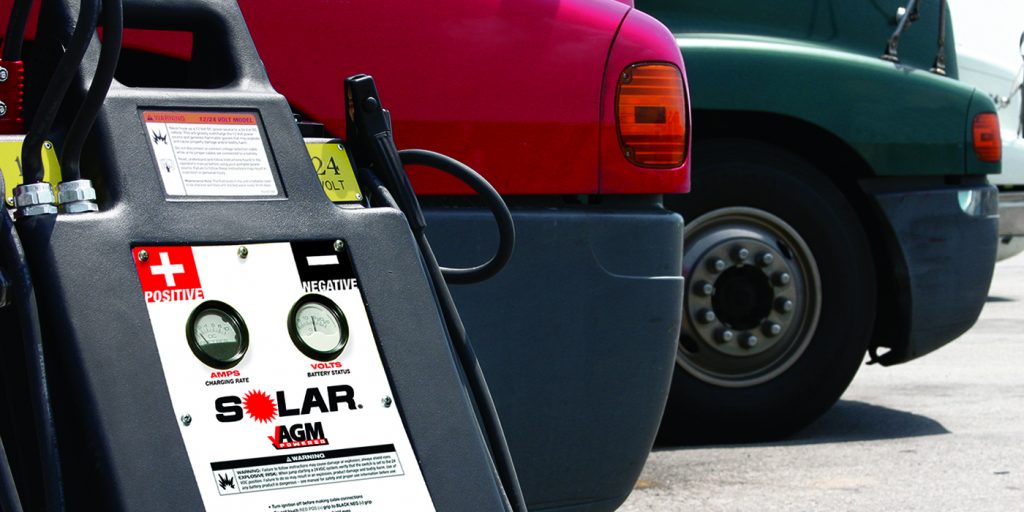Fleets make a tremendous investment in vehicle batteries. For that reason, notes Jim O’Hara, vice president of marketing at Clore Automotive, “it is critical to deploy the right equipment to protect that investment by monitoring the starting and charging systems that impact battery health. Fleets should be equipped with tools that can diagnose battery and charging system issues, and address fundamental electrical system problems.
“No matter how effectively a fleet deploys those tools, there will be circumstances that result in no-start conditions due to battery weakness,” O’Hara adds. “Those could be due to extreme weather, but when such circumstances occur, fleets must be able to quickly and efficiently react. For example, investing in a heavy-duty jump starter is one way to resolve those situations and limit downtime.”

As in most cases, proper preventive maintenance can go a long way toward eliminating battery and other electrical issues in the first place. Among Clore Automotive’s recommendations, according to O’Hara, are to test batteries every time a vehicle is serviced. “We recommend a tester with a capacity of 2,000 CCA that not only provides a pass/fail result but also a predictive measure, such as the specific resistance value of each battery.
“Fleets can use this information to better manage battery lifecycles,” O’Hara continues. “The ability to accurately assess the charging and starting system of each vehicle is also critical for long-term battery health and should be a feature of any testing solution. For instance, if a vehicle has a charging problem, this can result in undercharging or overcharging the batteries, and either condition can result in a significantly shorter battery lifespan.”
Vicki Hall, director of transportation technical solutions at EnerSys, the manufacturer of Odyssey batteries, points out that fleets should not neglect battery maintenance basics. This means keeping cables and terminal connections tight, clean and free of corrosion, and batteries at a high state of charge to ensure maximum performance. “With typical accessory and vehicle support loads, batteries can become deeply discharged, which can happen over extended holidays and when vehicles are in the shop for maintenance,” she relates.
“Additionally, cold temperatures can magnify problems for batteries, as they impact the ability to provide power,” Hall adds. “To make matters worse, the colder the engine, the more energy required to start it. Trying to start trucks with a low state of charge can cause high amperages, which can overheat the starter and damage battery cables. Fleets should keep any key-off parasitic loads to a minimum.”
Take the time to make sure that seasonal loads are covered and there’s enough power to the batteries to maintain a full state of charge, advises Jonathan Smith, assistant director of aftermarket sales and marketing at Leece-Neville Heavy Duty Systems, a division of Prestolite Electric Inc. “We recommend calculating all loads at idle for your worst-case scenario winter day to make sure you still have enough alternator output to meet your needs,” he says.
“Obviously, during the winter when you’re running the heater, defroster, lights and more, you’re going to draw more power,” Smith adds. “If you test and read all of the amperage draws of the loads before the vehicle hits the road, and spec your alternator accordingly, you can support all of the actual loads. Don’t just throw bigger batteries on the truck. Build the electrical system to the spec of the loads you require.
“A voltage drop test on the line between the alternator and the battery will confirm that you are getting the maximum current from the alternator to make sure there is a full state of charge,” Smith continues. “And keeping batteries clean, especially during the winter considering the salt used on the roads, is extremely important.”

When it comes to batteries, relates Jeff Coleman, vice president of sales, original equipment batteries at East Penn Manufacturing Co., it’s always a good idea to practice opportunity charging. “That means connecting a charger to the battery pack as soon as the truck is pulled into the service bay,” he explains. “This practice will refresh the batteries and offset the effects of key-off and parasitic loads during scheduled maintenance. This is especially important in winter since the batteries are put to the test during colder weather.
“Prior to charging,” Coleman adds, “confirm the state-of-charge of the batteries. If it’s below 12.4 volts, the pack should be fully recharged. Also remember that the fully charged voltage is different for flooded and AGM batteries. Flooded batteries are fully charged at 12.65 volts and AGM batteries are fully charged at 12.85 volts.”
Vehicle charging system design, fleet driving patterns and an increase in electronic loads on late model equipment can all prevent multi-battery packs form achieving a full state of charge, notes Jim O’Hara at Clore Automotive. But no matter the cause, he adds, the result is detrimental to battery health and life. Successfully bringing the batteries back to full charge will prevent sulfation build-up and support long battery life.
“Discharged batteries are far more susceptible to deterioration from sulfation than batteries that are kept at or near full charge,” O’Hara says. “While returning battery packs to full charge as often as possible should be part of a standard service routine, a challenge with doing that is time. A four-battery pack that utilizes 120AH batteries and is 20% discharged when it comes in for service needs to have approximately 100AH returned during that service event. The best way to address that is with faster charging, with a 100A charging capability being the desired minimum charge rate.”
In cold temperatures, notes Vicki Hall at EnerSys, a simple approach is to use batteries that have low resistance and provide better cranking ability. “The battery should also have adequate reserve capacity to supply the expected hotel loads,” she says.
“Thin Plate Pure Lead (TPPL) AGM batteries, by design, provide cranking power and reserve capacity at low temperatures due to their low internal resistance,” Hall continues. “This allows for faster recharge from the alternator, ensuring the batteries are maintained at the highest state of charge possible. TPPL batteries are the best option to meet both power and energy needs in cold weather.”
East Penn’s Coleman points out that choosing the right battery can prevent service problems or costly replacements. “Batteries with AGM technology have a faster charge recovery compared to standard flooded designs and self-discharge at a slower rate,” he explains. “That enables the battery pack to maintain a higher state of charge during winter when you need cold cranking power the most. Plus, running additional winter items such as heated wipers and auxiliary cab heaters requires a battery with a better cycle life like an AGM design.
“Often, however, batteries undergo so much heat in warmer Februarys that they lose the necessary capacity and resiliency to have the power needed for winter temperatures,” Coleman adds. “Although it sounds counterintuitive, one of the best methods to protect your battery’s performance in the cold is to protect it from the heat. Battery designs with some type of thermal or heat protection are best equipped to maximize the truck’s electrical system performance in hot or cold weather, season after season.”
For more on ensuring startability in winter weather, click here.














